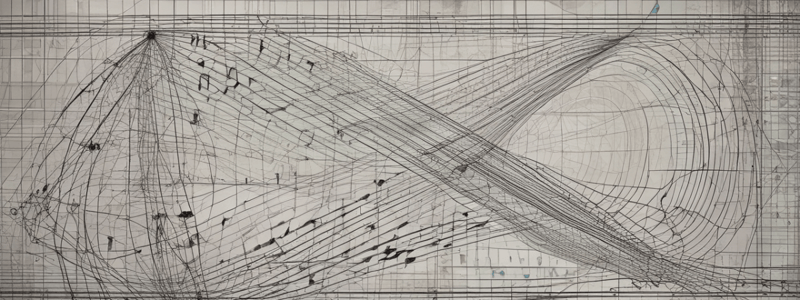Podcast
Questions and Answers
What is the fundamental concept in algebra that allows us to expand a product of a single value and a sum of values into a sum of products?
What is the fundamental concept in algebra that allows us to expand a product of a single value and a sum of values into a sum of products?
The distributive property
Write the equation that represents the distributive property, where a, b, and c are any numbers.
Write the equation that represents the distributive property, where a, b, and c are any numbers.
a(b + c) = ab + ac
How can the distributive property be used to simplify a linear equation, such as 2(x + 3) = 7?
How can the distributive property be used to simplify a linear equation, such as 2(x + 3) = 7?
By expanding the left-hand side of the equation using the distributive property, resulting in 2x + 6 = 7.
What are the two ways in which the distributive property can be applied in linear equations?
What are the two ways in which the distributive property can be applied in linear equations?
What is the benefit of applying the distributive property to a linear equation?
What is the benefit of applying the distributive property to a linear equation?
What is the result of applying the distributive property to the equation 2(x + 3) = 7?
What is the result of applying the distributive property to the equation 2(x + 3) = 7?
Study Notes
Distributive Property in Linear Equations
The distributive property is a fundamental concept in algebra, and it plays a crucial role in solving linear equations.
Definition
The distributive property states that for any numbers a, b, and c, the following equation holds:
a(b + c) = ab + ac
This property allows us to expand a product of a single value and a sum of values into a sum of products.
Applying the Distributive Property to Linear Equations
In the context of linear equations, the distributive property is used to expand and simplify equations. For example, consider the linear equation:
2(x + 3) = 7
Using the distributive property, we can expand the left-hand side of the equation as:
2x + 6 = 7
This simplifies the equation, making it easier to solve for x.
Key Points
- The distributive property allows us to expand a product of a single value and a sum of values into a sum of products.
- In linear equations, the distributive property is used to simplify and solve equations.
- The property can be applied in both directions: to expand an equation or to factor an equation.
By mastering the distributive property, you'll become proficient in solving linear equations and be better equipped to tackle more complex algebraic expressions.
Distributive Property in Linear Equations
Definition
- The distributive property states that for any numbers a, b, and c, the equation
a(b + c) = ab + acholds.
Applying the Distributive Property to Linear Equations
- The distributive property is used to expand and simplify linear equations.
- It allows us to expand a product of a single value and a sum of values into a sum of products.
- Example:
2(x + 3) = 7can be expanded to2x + 6 = 7using the distributive property.
Key Points
- The distributive property enables us to convert a product into a sum of products.
- It is used to simplify and solve linear equations.
- The property can be applied in both directions: to expand an equation or to factor an equation.
- Mastering the distributive property is crucial for solving linear equations and tackling more complex algebraic expressions.
Studying That Suits You
Use AI to generate personalized quizzes and flashcards to suit your learning preferences.
Description
Learn how to apply the distributive property to solve linear equations, a fundamental concept in algebra. Understand the definition and application of this property.




